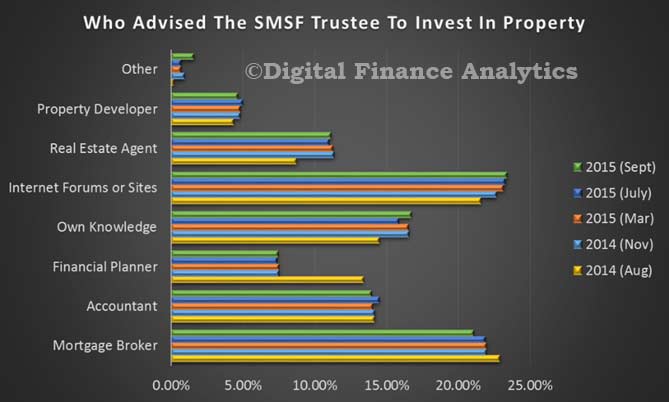As we round out the household segmentation analysis contained in the recently released Property Imperative report, today we look at residential property investment via a self managed superannuation fund.
APRA reports that Self-Managed Superannuation funds held assets were $589 billion at June 2015, a fall from $600 billion in March 2015.
Throughout the survey we noted an interest in investing in residential property via a self-managed superannuation funds (SMSFs). It is feasible to invest if the property meets certain specific criteria. In August the Government said such leveraged investments had their support, although the FSI inquiry had suggested such leverage should be banned. The rationale for this earlier recommendation was to prevent the unnecessary build-up of risk in the superannuation system and the financial system more broadly and fulfill the objective for superannuation to be a savings vehicle for retirement income, rather than a broader wealth management vehicle. Is this something which the Turnbull government might revisit?
Overall our survey showed that around 3.35% of households were holding residential property in SMSF, and a further 3% were actively considering it . Of these, 33% were motivated by the tax efficient nature of the investment, others were attracted by the prospect of appreciating prices (26%), the attractive finance offers available (15%), the potential for leverage (12%) and the prospect of better returns than from bank deposits (10%).
 We explored where SMSF Trustees sourced advice to invest in property, 21% used a mortgage broker, 23% online information, 11% a Real Estate Agent, 14% Accountant, and 7% a Financial Planner. Financial Planners are significantly out of favour in the light of recent bank disclosures and ASIC publicity on poor advice.
We explored where SMSF Trustees sourced advice to invest in property, 21% used a mortgage broker, 23% online information, 11% a Real Estate Agent, 14% Accountant, and 7% a Financial Planner. Financial Planners are significantly out of favour in the light of recent bank disclosures and ASIC publicity on poor advice.
 The proportion of SMSF in property was on average 34%.
The proportion of SMSF in property was on average 34%.

According to the fund level performance from APRA to June 2015, and DFA’s own research, Superannuation has become big business, with total assets now worth over $2 trillion (compare this with the $5.5 trillion in residential property in Australia), an increase of 9.9 % from last year.
